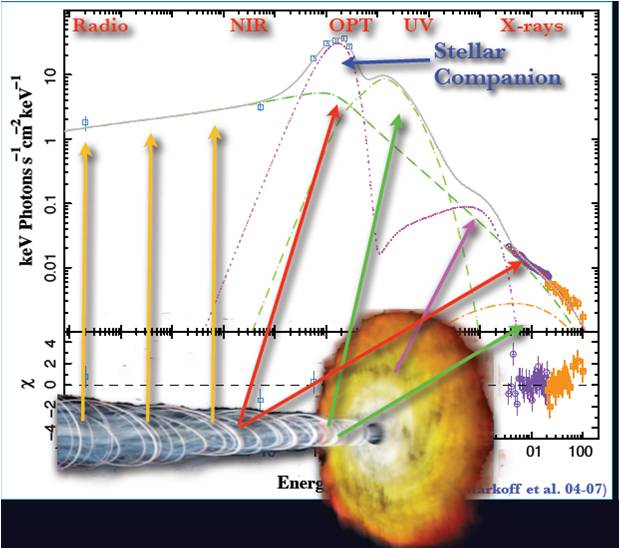| P8: Constraining Black Hole Accretion Physics through Multiwavelength Observations |
 |
 |
 |
|
Chun, Yoon Young (Sabancı Univ.) Lead Advisor: Dr Kalemci, Emrah (Sabancı Univ.) Co-Advisors: Prof. Corbel, Stephane (CEA) & Prof. Burderi, Luciano (UNICA) In the realm of astrophysics, one of the most mysterious objects is a black hole (BH) which has been predicted by Einstein's theory of General Relativity in the early 20th century. A mechanism that could create these mysterious objects is present in the stellar evolution theory in which all stars are thought to have different end-states depending on their initial masses. The collapse of massive stars in supernova explosions would result in stellar mass BHs with event horizons of a few kms. Such a heavy and compact object has very strong gravitational field around it. An isolated BH cannot be easily detected because the gravitational pull around it is too strong for anything to escape, even light. However, a BH in a binary system, which is also often named as an X-ray black hole binary, may be detected by its influence on the orbit of the companion star or by the radiation from an accretion disk that may form by material flowing onto the BH. Accretion converts gravitational potential into radiation and kinetic energy in the disk very efficiently. Because of this, the accretion disk around a BH is one of the most energetic sources of radiation in the universe and exhibits peculiar phenomena, especially in X-rays. Moreover, some of the infalling material may be ejected perpendicular to the disk under certain conditions as collimated jets. The jet emission is clearly observed with telescopes operating in the radio and infra-red band, but how much they contribute to the X-ray emission is an open question.  As the rate of material accreted changes in time, the brightness of the system and the distribution of photon energies (spectrum) also changes, those lead to the definition of spectral states. When a system is bright, an optically thick accretion disk exhibits a strong thermal emission, this state is called the High/Soft state (HS). At low accretion rates, the thermal emission decreases and the spectrum hardens, i.e. the fraction of the soft X-ray (<10keV) flux in the X-ray flux drops, and this state is called the Low/Hard state (LH). In LH state of BHs, all of the fundamental accretion components, the accretion disk, the hot corona and the jet, are observed from the longest wavelengths in the electromagnetic spectrum (radio band) to the shortest ones in gamma-rays. Therefore a multi-wavelength approach is required to understand the geometry, and other physical properties of the accretion components. In addition to the spectral analysis, the temporal analysis, eg. X-ray variability, low frequency QPOs in the power density spectra, time lags, etc., in the LH state could also provide useful information. Thus, understanding the accretion geometry, and the evolution of the accretion components in the LH state of BHs via multi-wavelength analysis with the interplay between the spectral and temporal analyses is the main goal of the project. Since X-rays are completely absorbed by the atmosphere, observations in X-rays should be done in space using several astronomical satellites, e.g. RXTE, Suzaku, XMM-Newton, Chandra. For the radio, the ATCA (Australia Telescope Compact Array) and the VLA are often utilized whereas the SMARTS telescope system in Chile will be used for infra-red and optical. With the data obtained via the archive or own observations, spectral and temporal evolution of the black holes in the hard state will be carried out. One of the important aspects of this work is to understand how the inner edge of the accretion disk evolves as a function of X-ray luminosity, and this will be done analysing the iron emission line caused by the reflection of high energy photons by the disk. Another important aspect of the PhD project is to provide feedback to the proprietary broad-band jet models developed by a member of the ITN and to test these models in different brightness levels with different X-ray spectral properties.
|